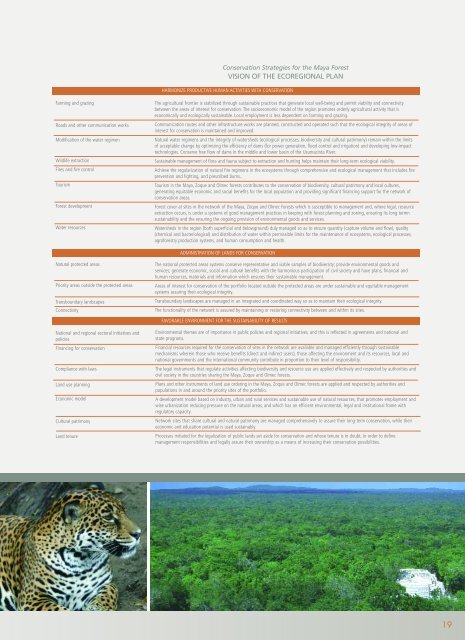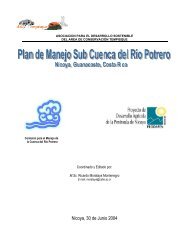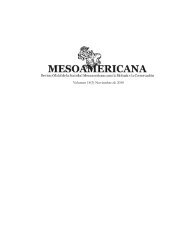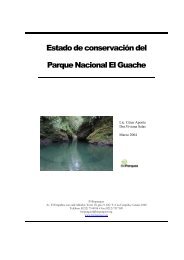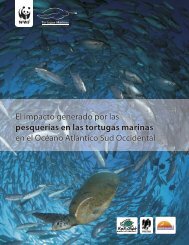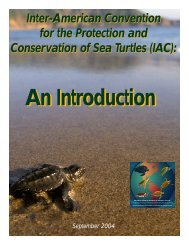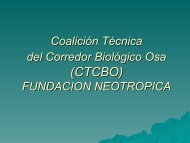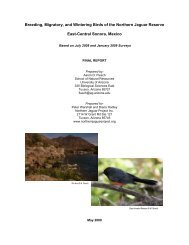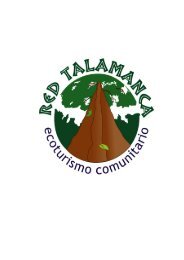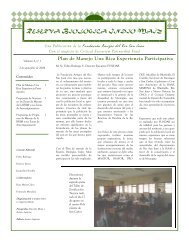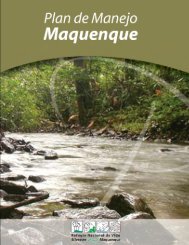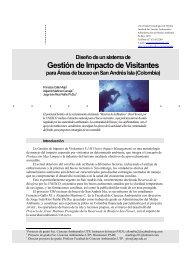Estrategias <strong>para</strong> la Conservación de la S<strong>el</strong>va MayaVISIÓN DEL PLAN ECORREGIONALCOMPATIBILIZAR ACTIVIDADES PRODUCTIVAS HUMANAS CON LA CONSERVACIÓN ABATEMENTAgricultura y ganaderíaCarreteras y otras obras de comunicaciónModificación d<strong>el</strong> régimen hídricoExtracción de vida silvestreIncendios y manejo d<strong>el</strong> fuegoTurismoDesarrollo forestalRecursos hídricosLa frontera agropecuaria está estabilizada con prácticas sostenibles que generan bienestar local, y permiten la viabilidad y conectividadentre las áreas de interés <strong>para</strong> la conservación. El mod<strong>el</strong>o de desarrollo socio-económico de la región promueve la actividad agropecuariaordenada, económica y ecológicamente sostenible. El empleo local ha reducido su dependencia de la agricultura y la ganadería.Las vías de comunicación y otras obras de infraestructura son planificadas, construidas y operadas de forma que las áreas de interés <strong>para</strong>la conservación mantienen y mejoran su integridad ecológica.Los regímenes hidrológicos naturales y la integridad de las cuencas (procesos ecológicos, biodiversidad y patrimonio cultural) se mantienendentro de límites de cambio aceptable con la optimización de la eficiencia de las presas (de generación <strong>el</strong>éctrica, control de inundaciones yriego) y <strong>el</strong> desarrollo de tecnologías de bajo impacto ambiental. Conservar <strong>el</strong> flujo libre de represas en las cuencas media y baja d<strong>el</strong> ríoUsumacinta.El manejo sustentable de las poblaciones de flora y fa<strong>una</strong> sujetas a extracción y cacería contribuye a mantener su viabilidad ecológica en <strong>el</strong>largo plazo.Lograr la regularización de los regímenes naturales d<strong>el</strong> fuego en los ecosistemas a través d<strong>el</strong> manejo integral y ecológico que incluye laprevención, combate y las quemas prescritas.El turismo en la S<strong>el</strong>vas Maya, Zoque y Olmeca contribuye a la conservación de la biodiversidad, <strong>el</strong> patrimonio cultural y las culturas locales,generando beneficios económicos y sociales en forma equitativa <strong>para</strong> la población local y apoyando significativamente <strong>el</strong> financiamiento d<strong>el</strong>a red de áreas de conservación.La cobertura forestal de los sitios d<strong>el</strong> portafolio de la S<strong>el</strong>vas Maya, Zoque y Olmeca susceptible a manejo y en áreas donde es legal laextracción de recursos se encuentra bajo esquemas de “buenas practicas” de manejo de acuerdo a un ordenamiento forestal, garantizandosu existencia sustentable y la provisión de bienes y servicios ambientales.Los recursos hídricos (superficiales y subterráneos) existentes en la región se encuentran debidamente manejados garantizando la cantidad(volumen de captación y flujo), calidad (química y bacteriológica) y distribución (red) d<strong>el</strong> agua dentro de limites permisibles <strong>para</strong> <strong>el</strong>mantenimiento de ecosistemas, procesos ecológicos, sistemas de producción agrícola forestal, así como <strong>para</strong> <strong>el</strong> consumo y la saludhumana.ADMNISTRACIÓN DEL TERRITORIO PARA LA CONSERVACIÓNTEMENTÁreas Naturales ProtegidasÁreas prioritarias fuera de áreas protegidasPaisajes transfronterizosConectividadLos sistemas nacionales de áreas protegidas conservan muestras representativas y viables de la biodiversidad, y proveen bienes y serviciosambientales, generan beneficios económicos, sociales y culturales, con la participación en armonía de la sociedad civil, y cuentan con losplanes y recursos financieros, humano, materiales, información <strong>para</strong> su manejo sostenible.Las áreas de interés <strong>para</strong> la conservación d<strong>el</strong> portafolio ubicadas fuera de las áreas protegidas están bajo esquemas de manejo sostenibley equitativo que aseguran su integridad ecológica.Los paisajes transfronterizos son manejados de manera integral y coordinada con <strong>el</strong> fin de mantener su integridad ecológica.La funcionalidad d<strong>el</strong> portafolio se garantiza por medio d<strong>el</strong> mantenimiento o restauración de la conectividad entre y dentro de sus sitios.AMBIENTE FAVORABLE PARA LA SOSTENIBILIDAD DE LOS RESULTADOSBATEMENTIniciativas y políticas secto-riales nacionales yregionalesFinanciamiento <strong>para</strong> la conservaciónCumplimiento de leyesOrdenamiento territorialMod<strong>el</strong>o económicoPatrimonio culturalTenencia de la tierraLas políticas públicas, acuerdos e iniciativas regionales consideran r<strong>el</strong>evantes los asuntos ambientales en sus planteamientos, y <strong>el</strong>lo se vereflejado en los acuerdos y programas nacionales y estatales.Se disponen y se manejan eficientemente los recursos financieros requeridos <strong>para</strong> la conservación de los sitios d<strong>el</strong> portafolio a través demecanismos sostenibles donde quienes reciben beneficios (usuarios directos e indirectos), quienes afectan <strong>el</strong> ambiente y sus recursos, losgobiernos locales y nacionales, y la comunidad internacional contribuyen proporcionalmente a su responsabilidad.Los instrumentos legales que regulan las actividades que afectan la biodiversidad y uso de recursos son aplicados efectivamente por lasautoridades y la sociedad civil en los países que comparten las S<strong>el</strong>vas Maya, Zoque y Olmeca.Los planes y otros instrumentos de ordenamiento territorial en las S<strong>el</strong>vas Maya, Zoque y Olmeca son aplicados y respetados por lasautoridades y la población en y alrededor de los sitios prioritarios d<strong>el</strong> portafolio.Un mod<strong>el</strong>o de desarrollo basado en la industria y servicios urbanos y rurales, en <strong>el</strong> uso sostenible de recursos naturales que promueve <strong>el</strong>empleo y la urbanización racional, reduciendo la presión sobre las áreas naturales, y que cuenta con un marco legal e institucionalambiental eficiente y capaz <strong>para</strong> regularlo.Los sitios d<strong>el</strong> portafolio que comparten patrimonio cultural y natural se manejan de manera integral asegurando su conservación en <strong>el</strong>largo plazo, al mismo tiempo que se aprovecha su potencial económico y educativo de manera sustentable.Iniciados procesos de legalización de las tierras públicas que han sido destinadas <strong>para</strong> la conservación y tierras cuya tenencia esté en duda,a fin de definir responsables de manejo y asegurar jurídicamente su propiedad, tratando de incrementar así sus posibilidades deconservación.18
Conservation Strategies for the Maya ForestVISION OF THE ECOREGIONAL PLANHARMONIZE PRODUCTIVE HUMAN ACTIVITIES WITH CONSERVATIONTEMENTFarming and grazingRoads and other communication worksModification of the water regimenWildlife extractionFires and fire controlTourismForest dev<strong>el</strong>opmentWater resourcesThe agricultural frontier is stabilized through sustainable practices that generate local w<strong>el</strong>l-being and permit viability and connectivitybetween the areas of interest for conservation. The socioeconomic mod<strong>el</strong> of the region promotes orderly agricultural activity that iseconomically and ecologically sustainable. Local employment is less dependent on farming and grazing.Communication routes and other infrastructure works are planned, constructed and operated such that the ecological integrity of areas ofinterest for conservation is maintained and improved.Natural water regimens and the integrity of watersheds (ecological processes, biodiversity and cultural patrimony) remain within the limitsof acceptable change by optimizing the efficiency of dams (for power generation, flood control and irrigation) and dev<strong>el</strong>oping low-impacttechnologies. Conserve free flow of dams in the middle and lower basin of the Usumacinta River.Sustainable management of flora and fa<strong>una</strong> subject to extraction and hunting h<strong>el</strong>ps maintain their long-term ecological viability.Achieve the regularization of natural fire regimens in the ecosystems through comprehensive and ecological management that includes fireprevention and fighting, and prescribed burns..Tourism in the Maya, Zoque and Olmec forests contributes to the conservation of biodiversity, cultural patrimony and local cultures,generating equitable economic and social benefits for the local population and providing significant financing support for the network ofconservation areas.Forest cover at sites in the network of the Maya, Zoque and Olmec Forests which is susceptible to management and, where legal, resourceextraction occurs, is under a systems of good management practices in keeping with forest planning and zoning, ensuring its long termnsustainability and the ensuring the ongoing provision of environmental goods and services.Watersheds in the region (both superficial and b<strong>el</strong>owground) duly managed so as to ensure quantity (capture volume and flow), quality(chemical and bacteriological) and distribution of water within permissible limits for the maintenance of ecosystems, ecological processes,agroforestry production systems, and human consumption and health.ADMINISTRATION OF LANDS FOR CONSERVATIONTEMENTNatural protected areasPriority areas outside the protected areasTransboundary landscapesConnectivityThe national protected areas systems conserve representative and viable samples of biodiversity; provide environmental goods andservices; generate economic, social and cultural benefits with the harmonious participation of civil society and have plans, financial andhuman resources, materials and information which ensures their sustainable management.Areas of interest for conservation of the portfolio located outside the protected areas are under sustainable and equitable managementsystems assuring their ecological integrity.Transboundary landscapes are managed in an integrated and coordinated way so as to maintain their ecological integrity.The functionality of the network is assured by maintaining or restoring connectivity between and within its sites.FAVORABLE ENVIRONMENT FOR THE SUSTAINABILITY OF RESULTSBATEMENTNational and regional sectoral initiatives andpoliciesFinancing for conservationCompliance with lawsLand use planning<strong>Eco</strong>nomic mod<strong>el</strong>Cultural patrimonyLand tenureEnvironmental themes are of importance in public policies and regional initiatives, and this is reflected in agreements and national andstate programs.Financial resources required for the conservation of sites in the network are available and managed efficiently through sustainablemechanisms wherein those who receive benefits (direct and indirect users), those affecting the environment and its resources, local andnational governments and the international community contribute in proportion to their lev<strong>el</strong> of responsibility.The legal instruments that regulate activities affecting biodiversity and resource use are applied effectiv<strong>el</strong>y and respected by authorities andcivil society in the countries sharing the Maya, Zoque and Olmec forests.Plans and other instruments of land use ordering in the Maya, Zoque and Olmec forests are applied and respected by authorities andpopulations in and around the priority sites of the portfolio.A dev<strong>el</strong>opment mod<strong>el</strong> based on industry, urban and rural services and sustainable use of natural resources, that promotes employment andwise urbanization reducing pressure on the natural areas, and which has an efficient environmental, legal and institutional frame withregulatory capacity.Network sites that share cultural and natural patrimony are managed comprehensiv<strong>el</strong>y to assure their long-term conservation, while theireconomic and education potential is used sustainably.Processes initiated for the legalization of public lands set aside for conservation and whose tenure is in doubt, in order to definemanagement responsibilities and legally assure their ownership as a means of increasing their conservation possibilities.19


